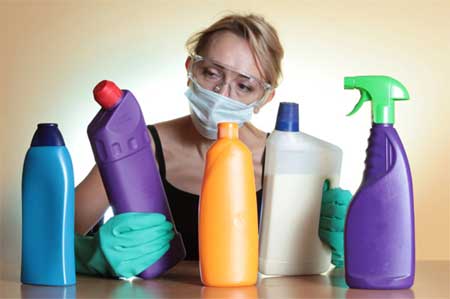The Truth about Household Cleaners
Let’s face it: Green is the new black. Companies introduced 13,000 new "natural" products last year and another 5,000 have hit shelves already this year. Whether it’s the food they eat or the stuff they own, women everywhere are making the choice to go natural.
05/2014
Some conventional household cleaners also sully the environment with ingredients that can contaminate the air, water, and soil when they are manufactured, used, and thrown away. Cleaning products with phosphates, for example, can cause “dead zones” in lakes and streams.
MAKE YOUR OWN
It’s easy to make your own green cleaning supplies using basic ingredients such as baking soda, lemon juice, vinegar, and salt. Though some take a little more elbow grease than conventional cleaners, they are a lot safer. Try some of these simple homemade green cleaning supplies:
Creamy soft scrub
This is a great mild abrasive cleaner, and can be used for most tubs, showers, toilets, countertops, and sinks, including stainless steel, Corian, Formica, engineered quartz, and glass.
Mix 1 cup baking soda with 1/4 cup vegetable-based soap in a glass jar. You can add more soap if you want a creamier soft scrub. Stir. Add 2 teaspoons vegetable glycerin (available at most natural food stores and many drugstores) if you want it to keep it for up to a year; otherwise, it will harden. You can add a couple of drops of a favoUrite organic essential oil (extracted from plant parts) if you want a pleasant scent.
All-purpose green cleaner
Combine 2 cups white vinegar with 2 cups water in a spray bottle. Again, you can scent with a few drops of essential oil. As with all acidic solutions, do not use this on marble. It will destroy the finish and can even etch the surface. Another option is 3 tablespoons baking soda dissolved in warm water in a spray bottle.
Scouring powder
Mix 3 parts baking soda with 1 part borax (found in the laundry aisle). Keep handy in a shaker jar and sprinkle with some essential oil if you like. Borax should not be ingested, so store out of reach of children, and can cause skin irritation in some people.
Furniture polish
Shine up your favourite furniture by wiping it down with a mix of 1/4-cup olive oil with four tablespoons white distilled vinegar and 20 to 30 drops of lemon essential oil. Don’t have the latter? Swap it for two teaspoons of lemon juice and store the polish in the fridge after you have cleaned, to keep it fresh.
Laundry detergent
This detergent gets your clothes clean without the extra chemicals. First, make soap flakes by grating a pure vegetable soap bar with a cheese grater. Then, mix one cup of the flakes with 1/2-cup of washing soda (found in the laundry aisle) and 1/2-cup of borax, a powder or crystalline salt water softener and disinfectant. Use one to two tablespoons of the detergent per load of laundry.
Ventilate, ventilate, ventilate! While cleaning with conventional cleaners, open windows and doors to allow air to circulate. This will reduce the buildup of chemicals.
CLEANING TOOLS
Green your towels
Use cloth instead of paper towels. Good ones can easily be made by cutting up old T-shirts, towels, or sheets. If you prefer paper towels for certain tasks, make sure they’re made from post-consumer recycled fibres and free of chlorine bleach. If every household in South Africa replaced just one roll of virgin paper towels with 100% recycled ones, we’d save thousands of trees!
SAVVY SHOPPER
If your regular cleaning products have warnings such as: poison, danger, caution, then you need to think about changing brand or opting for a more natural alternative. And don't be fooled by products that claim to be "natural" or "eco-friendly", rather shop for items that state specifics like "phosphate free" and "biodegradable".
Consider replacing the following items with natural alternatives:
Air fresheners: Conventional air fresheners can contain hormone-disrupting phthalates, cancer-causing chemicals such as formaldehyde and benzene, and other volatile organic compounds (VOCs) such as d-limonene that can irritate your eyes, skin, and respiratory system and cause headaches, nausea, and dizziness. Skip that ”mountain fresh” scent created by synthetic fragrances. Many air fresheners contain hormone-disrupting phthalates.
Antibacterial products: Antibacterial products are not any more effective than plain soap and hot water, except in situations involving immune compromised individuals. And they have serious downsides. The commonly used Triclosan is causing deformities in tadpoles in U.S. lakes and streams–and has recently been found in human breast milk. In addition, Triclosan may encourage the growth of “superbugs” by promoting the growth of bacteria that are resistant to it.
Chlorine Bleach: Sold by itself and as an ingredient in many household cleaners, chlorine bleach is irritating to the lungs and eyes and responsible for numerous poisoning incidents every year. Once in a wastewater treatment system, reacts with other chemicals, potentially forming even more-harmful substances.
Detergents containing phosphates: Largely phased out of most laundry detergents, phosphates are still found in dishwashing detergents. The nutrients they add to our water systems can result in increased growth of algae and plants, as well as an increase in the bacteria that feed on the algae and plants when they die. These bacteria rob the water of its dissolved oxygen, killing fish and other aquatic organisms.
Spray cleaners: While convenient, spray cleaners are more closely linked to asthma and respiratory irritation than similar liquid cleaners. The fine sprays of droplets of cleaning products have been linked to increased risks of asthma, but using a similar cleaner in a non-spray form has not shown any increased risk. A simple switch can protect your respiratory health.

